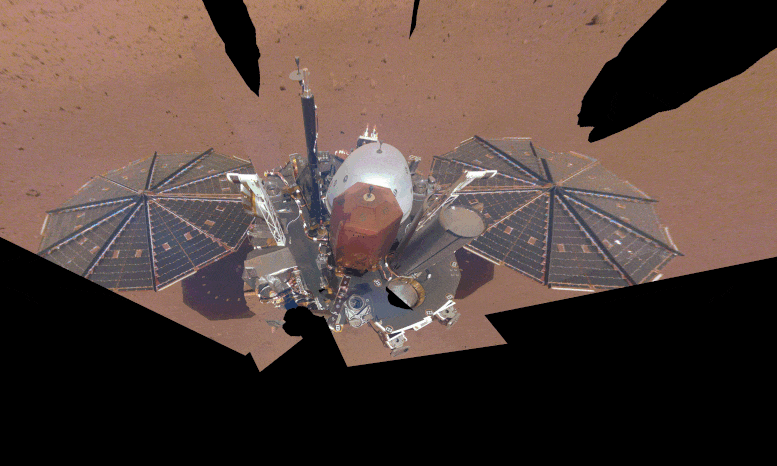
Αυτή η εικόνα εναλλάσσεται μεταξύ της πρώτης και της τελευταίας selfie του Insight, για λόγους σύγκρισης. Χρησιμοποιώντας την κάμερα στον ρομποτικό του βραχίονα, ο ανιχνευτής InSight της NASA απαθανάτισε αυτές τις selfies στις 6 Δεκεμβρίου 2018 -μόλις 10 ημέρες μετά την προσγείωση στον Άρη- και στις 24 Απριλίου 2022. Ένα παχύ στρώμα σκόνης μπορεί να φανεί στον ανιχνευτή και στα ηλιακά πάνελ του η τελευταία εικόνα. Πίστωση: NASA/JPL-Caltech
Ρίξτε μια πιο προσεκτική ματιά στο τι συμβαίνει με την ολοκλήρωση μιας αποστολής, καθώς η παροχή ρεύματος στο διαστημόπλοιο InSight συνεχίζει να μειώνεται.
κλείσιμο τέλος σε[{” attribute=””>NASA’s Mars InSight lander. The day is fast approaching when the spacecraft will fall silent, ending its history-making mission to reveal secrets of the Red Planet’s interior. Since the spacecraft’s power generation continues to decline as windblown dust on its solar panels thickens, the engineering team has already taken steps to continue as long as possible with what power remains. Despite these efforts, it won’t be long now, as the end is expected to come in the next few weeks.
Although InSight’s tightknit 25-to-30-member operations team – a small group compared to other Mars missions – continues to squeeze the most they can out of InSight, they’ve also begun taking steps to wind down the mission.
Here’s a glimpse of what that looks like.

This is NASA InSight’s first full selfie on Mars. It displays the lander’s solar panels and deck. On top of the deck are its science instruments, weather sensor booms, and UHF antenna. The selfie was taken on December 6, 2018 (Sol 10). Credit: NASA/JPL-Caltech
Preserving Data
With InSight (short for Interior Exploration using Seismic Investigations, Geodesy and Heat Transport), the most important of the final steps of the mission is storing its trove of data and making it accessible to researchers around the world. Already, the data from the lander has yielded details about Mars’ interior layers, its liquid core, the surprisingly variable remnants beneath the surface of its mostly extinct magnetic field, weather on this part of Mars, and lots of quake activity. More insights are sure to follow, as scientists continue to sift through the data.
InSight’s seismometer, provided by France’s Centre National d’Études Spatiales (CNES), has detected more than 1,300 marsquakes since the lander touched down in November 2018. The largest quake it detected measured a magnitude 5. It even recorded quakes from meteoroid impacts. Observing how the seismic waves from those quakes change as they travel through the planet offers an invaluable glimpse into Mars’ interior. Beyond that, these observations also provide a better understanding of how all rocky worlds form, including Earth and its Moon.

NASA’s InSight Mars lander took this final selfie on April 24, 2022, the 1,211th Martian day, or sol, of the mission. The lander is covered with far more dust than it was in its first selfie, taken in December 2018, not long after landing. Credit: NASA/JPL-Caltech
“Finally, we can see Mars as a planet with layers, with different thicknesses, compositions,” said Bruce Banerdt of NASA’s Jet Propulsion Laboratory (JPL) in Southern California, the mission’s principal investigator. “We’re starting to really tease out the details. Now it’s not just this enigma; it’s actually a living, breathing planet.”
The seismometer readings will join the only other set of extraterrestrial seismic data, from the Apollo lunar missions, in NASA’s Planetary Data System. They will also go into an international archive run by the Incorporated Research Institutions for Seismology, which houses “all the terrestrial seismic network data locations,” said JPL’s Sue Smrekar, InSight’s deputy principal investigator. “Now, we also have one on Mars.”
Smrekar said the data is expected to continue yielding discoveries for decades.

The rocket that launched NASA’s InSight lander to Mars in 2018 is seen at Vandenberg Air Force Base, now called Vandenberg Space Force Base. Credit: NASA/JPL-Caltech/Charles Babir
Managing Power
Earlier this summer, the lander had so little power remaining that the mission turned off all of InSight’s other science instruments in order to keep the seismometer running. They even turned off the fault protection system that would otherwise automatically shut down the seismometer if the system detects that the lander’s power generation is dangerously low.
“We were down to less than 20% of the original generating capacity,” said Banerdt. “That means we can’t afford to run the instruments around the clock.”
Recently, after a regional dust storm added to the lander’s dust-covered solar panels, the team decided to turn off the seismometer altogether in order to save power. Now that the storm is over, the seismometer is collecting data again. However, the mission expects the lander only has enough power for a few more weeks.
Of the seismometer’s array of sensors, only the most sensitive were still operating, said Liz Barrett, who leads science and instrument operations for the team at JPL, adding, “We’re pushing it to the very end.”
δίδυμες συσκευασίες
Το σιωπηλό μέλος της ομάδας είναι το ForeSight, το πλήρους μεγέθους μηχανολογικό μοντέλο της InSight στην JPL Επιτόπιο εργαστήριο εργαλείων. Οι μηχανικοί χρησιμοποίησαν το ForeSight για να εξασκήσουν πώς το InSight θα μπορούσε να τοποθετήσει επιστημονικά όργανα στην επιφάνεια του Άρη χρησιμοποιώντας το ρομποτικό βραχίονα του rover, Τεχνικές δοκιμών Για να εισαγάγετε τον αισθητήρα θερμοκρασίας του αισθητήρα Κολλώδες αρειανό έδαφοςανάπτυξη μεθόδων Μείωση θορύβου Παραλήφθηκε από σεισμόμετρο.
Το Forsight θα τοποθετηθεί σε κουτί αποθήκευσης. «Θα το γεμίσουμε με στοργική φροντίδα», είπε ο Banerdt. «Ήταν ένα εξαιρετικό εργαλείο, ένας εξαιρετικός σύντροφος για εμάς σε όλη αυτή την αποστολή».

Σε έναν δοκιμαστικό χώρο στο Εργαστήριο Jet Propulsion, οι μηχανικοί εκπαιδεύονται για την ανάπτυξη οργάνων InSight χρησιμοποιώντας το ForeSight, ένα αντίγραφο πλήρους μεγέθους του προσεδαφιστή που θα κινητοποιηθεί μόλις ολοκληρωθεί η αποστολή. Πολλοί μηχανικοί φορούν γυαλιά ηλίου για να μπλοκάρουν τα έντονα κίτρινα φώτα που μιμούνται το φως του ήλιου καθώς εμφανίζονται στον Άρη. Πίστωση: NASA/JPL-Caltech/IPGP
Ανακοίνωση λήξης αποστολής
Όταν το InSight χάνει δύο διαδοχικές συνεδρίες επαφής με το διαστημόπλοιο σε τροχιά στον Άρη, μέρος του Mars Relay NetworkΗ NASA θα ανακοινώσει το τέλος της αποστολής. Ωστόσο, αυτός ο κανόνας ισχύει μόνο εάν η αιτία της απώλειας σύνδεσης είναι ο ίδιος ο ανιχνευτής, δήλωσε ο διαχειριστής του δικτύου Roy Gladden της JPL. Επειτα, Δίκτυο Βαθύ Διαστήματος της NASA Θα συνεχίσει να ακούει για λίγο, για κάθε ενδεχόμενο.
Ωστόσο, δεν θα υπάρξουν ηρωικές ενέργειες για επανασύνδεση με το InSight. Αν και ένα γεγονός εξοικονόμησης αποστολής, όπως ένας δυνατός άνεμος που φυσάει για να καθαρίσει τα πάνελ, δεν είναι αδύνατο, θεωρείται εντελώς απίθανο.
Στο μεταξύ, όσο το InSight παραμένει σε επαφή, η ομάδα θα συνεχίσει να συλλέγει δεδομένα. «Θα συνεχίσουμε να κάνουμε επιστημονικές μετρήσεις για όσο το δυνατόν περισσότερο», είπε ο Banerdt. “Είμαστε στο έλεος του Άρη. Ο καιρός στον Άρη δεν είναι βροχή και χιόνι, ο καιρός στον Άρη είναι σκόνη και άνεμος.”
Περισσότερα για την αποστολή
Το Jet Propulsion Laboratory (JPL) της NASA διαχειρίζεται το πρόγραμμα InSight της Διεύθυνσης Επιστημονικής Αποστολής της NASA. Το InSight αποτελεί μέρος του Προγράμματος Ανακάλυψης της NASA, το οποίο διαχειρίζεται το Marshall Space Flight Center της υπηρεσίας στο Χάντσβιλ της Αλαμπάμα. Η Lockheed Martin Space του Ντένβερ έχει κατασκευάσει το διαστημικό σκάφος InSight, συμπεριλαμβανομένου ενός σταθμού κρουαζιέρας και προσγείωσης, και υποστηρίζει τις λειτουργίες του διαστημικού σκάφους της αποστολής.
Ένας αριθμός Ευρωπαίων εταίρων, συμπεριλαμβανομένου του γαλλικού Εθνικού Κέντρου Διαστημικών Μελετών (CNES) και του Γερμανικού Κέντρου Αεροδιαστημικής (DLR), υποστηρίζουν την αποστολή InSight. Το Εθνικό Κέντρο Διαστημικών Μελετών παρείχε το όργανο Inner Structure Seismic Experiment (SEIS) στη NASA, με τον κύριο ερευνητή του IPGP (Institut de Physiques d’Institut d’Institut d’Institut d’Institut d’Institut du Physique στο κόσμος στο Παρίσι). Σημαντικές συνεισφορές στο Κοινό Σύστημα Περιβαλλοντικών Πληροφοριών προήλθαν από το IPGP. Max Planck Institute for Solar System Research (MPS) στη Γερμανία. Ελβετικό Ομοσπονδιακό Ινστιτούτο Τεχνολογίας (ETH Zurich) στην Ελβετία.[{” attribute=””>Imperial College London and Oxford University in the United Kingdom; and JPL. DLR provided the Heat Flow and Physical Properties Package (HP3) instrument, with significant contributions from the Space Research Center (CBK) of the Polish Academy of Sciences and Astronika in Poland. Spain’s Centro de Astrobiología (CAB) supplied the temperature and wind sensors, and the Italian Space Agency (ASI) supplied a passive laser retroreflector.

“Ερασιτέχνης διοργανωτής. Εξαιρετικά ταπεινός web maven. Ειδικός κοινωνικών μέσων Wannabe. Δημιουργός. Thinker.”
